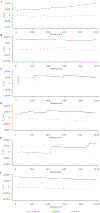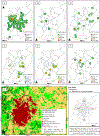Occurrence and spatial distribution of triatomines (Hemiptera: Reduviidae) in the urban area of the municipality of Montes Claros, Northern Minas Gerais, Brazil
- PMID: 34825495
- PMCID: PMC10787537
- DOI: 10.1111/zph.12897
Occurrence and spatial distribution of triatomines (Hemiptera: Reduviidae) in the urban area of the municipality of Montes Claros, Northern Minas Gerais, Brazil
Abstract
The north of the Brazilian state of Minas Gerais is classified as an area of high risk of vectorial transmission of Chagas disease (CD) or of reestablishing transmission in the home, but the Chagas disease control programme is disjointed. The study evaluated the occurrence, natural infection and the spatial distribution of species of triatomines associated with climatic variations in the urban area of Montes Claros, a municipality endemic to CD in the north of Minas Gerais, Brazil. Triatomine data were obtained from passive entomological surveillance actions of the Chagas Disease Control Program (Programa de Controle de Doença de Chagas-PCDCh), registered by the Zoonosis Control Center (Centro de Controle de Zoonoses-CCZ) from 2009 to 2019. A total of 277 triatomines belonging to eight species were collected, and of these, 203 insects were examined. It was found that 46.2% of triatomines were captured inside the home and 8.3% around the home. The natural infection rate was 6.9%; 14 specimens showed natural infection by Trypanosoma cruzi (12 females and 2 males), and of these, 13 were found in the home and one in an uninformed location. The number of triatomine records collected was significantly higher in the month of September (p = .01), and there was an inverse correlation between the number of triatomines and the relative humidity of the air (p < .001). It was verified that the highest triatomine densities are located in transition areas between urban infrastructure (32.12%) and pasture (25.72%). The diversity of species of triatomines infected with T. cruzi in residential units in urban areas in the municipality of Montes Claros is worrying, as it suggests a potential risk of transmission of the parasite to domestic animals and humans.
Keywords: Trypanosoma cruzi; Chagas disease; one health; spatial analysis; triatomines; urbanization.
© 2021 Wiley-VCH GmbH.
Conflict of interest statement
Conflict of Interest
The authors state that there is no conflict of interest.
Figures





Similar articles
-
Socio-environmental factors associated with the occurrence of triatomines (Hemiptera: Reduviidae) in an endemic municipality in northern Minas Gerais, Brazil.Zoonoses Public Health. 2024 Feb;71(1):34-47. doi: 10.1111/zph.13081. Epub 2023 Oct 4. Zoonoses Public Health. 2024. PMID: 37792668
-
Distribution and natural infection status of synantrophic triatomines (Hemiptera: Reduviidae), vectors of Trypanosoma cruzi, reveals new epidemiological scenarios for chagas disease in the Highlands of Colombia.PLoS Negl Trop Dis. 2021 Jul 19;15(7):e0009574. doi: 10.1371/journal.pntd.0009574. eCollection 2021 Jul. PLoS Negl Trop Dis. 2021. PMID: 34280203 Free PMC article.
-
Community-Based Entomological Surveillance Reveals Urban Foci of Chagas Disease Vectors in Sobral, State of Ceará, Northeastern Brazil.PLoS One. 2017 Jan 19;12(1):e0170278. doi: 10.1371/journal.pone.0170278. eCollection 2017. PLoS One. 2017. PMID: 28103294 Free PMC article.
-
Low risk for locally acquired Chagas disease in California: A review of human cases and triatomine submissions, 2013-2023.PLoS Negl Trop Dis. 2025 Apr 21;19(4):e0013036. doi: 10.1371/journal.pntd.0013036. eCollection 2025 Apr. PLoS Negl Trop Dis. 2025. PMID: 40258046 Free PMC article. Review.
-
Heterogeneity of Trypanosoma cruzi infection rates in vectors and animal reservoirs in Colombia: a systematic review and meta-analysis.Parasit Vectors. 2019 Jun 20;12(1):308. doi: 10.1186/s13071-019-3541-5. Parasit Vectors. 2019. PMID: 31221188 Free PMC article.
Cited by
-
Cardiac involvement in Chagas disease and African trypanosomiasis.Nat Rev Cardiol. 2024 Dec;21(12):865-879. doi: 10.1038/s41569-024-01057-3. Epub 2024 Jul 15. Nat Rev Cardiol. 2024. PMID: 39009679 Review.
-
Overview of Chagas disease surveillance in an endemic region in Southeastern Brazil.Rev Inst Med Trop Sao Paulo. 2023 Oct 9;65:e51. doi: 10.1590/S1678-9946202365051. eCollection 2023. Rev Inst Med Trop Sao Paulo. 2023. PMID: 37820247 Free PMC article.
-
Gastrointestinal Manifestations of Chagas Disease: A Systematic Review with Meta-Analysis.Am J Trop Med Hyg. 2023 Dec 4;110(1):10-19. doi: 10.4269/ajtmh.23-0323. Print 2024 Jan 3. Am J Trop Med Hyg. 2023. PMID: 38052078 Free PMC article.
References
-
- Abad-Franch F, Lima MM, Sarquis O, Gurgel-Gonçalves R, Sánchez-Martín M, Calzada J, Saldaña A, Monteiro FA, Palomeque FS, Santos WS, Angulo VM, Esteban L, Dias FB, Diotaiuti L, Bar ME, & Gottdenker NL (2015). On palms, bugs, and Chagas disease in the Americas. .Acta Tropica, 151, 126–141. 10.1016/j.actatropica.2015.07.005 - DOI - PubMed
-
- Abrahan LB, Gorla DE, & Catalá SS (2011). Dispersal of Triatoma infestans and other Triatominae species in the arid Chaco of Argentina: Flying, walking or passive carriage? The importance of walking females. Memórias do Instituto Oswaldo Cruz, 106(2), 232–239. 10.1590/S0074-02762011000200019 - DOI - PubMed
-
- Ab’sáber AN (1977) Os domínios morfoclimáticos na América ao Sul. São Paulo, Instituto de Geografia da USP. (Série Geomorfologia, 52).
-
- Alvares CA, Stape JL, Sentelhas PC, Gonçalves J. L. de M., & Sparovek G. (2013). Köppen’s climate classification map for Brazil. Meteorologische Zeitschrift, 22 (6), 711–728. 10.1127/0941-2948/2013/0507 - DOI
-
- Assis GFM, Azeredo BVM, Gorla D, Diotaiuti L, & Lana M. (2009). Entomological surveillance of Chagas disease in Berilo municipality, Jequitinhonha Valley, State of Minas Gerais, Brazil. Revista da Sociedade Brasileira de Medicina Tropical, 42(6), 615–621. 10.1590/S0037-86822009000600001 - DOI - PubMed
Publication types
MeSH terms
Grants and funding
LinkOut - more resources
Full Text Sources
Medical

